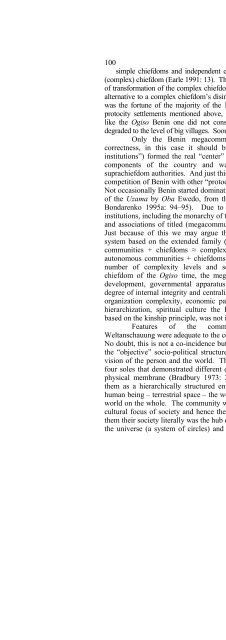Bondarenko Dmitri M. Homoarchy
Bondarenko Dmitri M. Homoarchy
Bondarenko Dmitri M. Homoarchy
Create successful ePaper yourself
Turn your PDF publications into a flip-book with our unique Google optimized e-Paper software.
100<br />
simple chiefdoms and independent communities is the typical fortune of the<br />
(complex) chiefdom (Earle 1991: 13). Thus, the megacommunity is a possible way<br />
of transformation of the complex chiefdom; a “positive” way in the sense that it is<br />
alternative to a complex chiefdom’s disintegration. So, evidently, the break-down<br />
was the fortune of the majority of the 130 early Bini chiefdoms, and about ten<br />
protocity settlements mentioned above, potential centers of complex chiefdoms,<br />
like the Ogiso Benin one did not consolidate their power over neighbors and<br />
degraded to the level of big villages. Sooner or later they were absorbed by Benin.<br />
Only the Benin megacommunity of the 13–19 th centuries (for<br />
correctness, in this case it should be said “the megacommunity political<br />
institutions”) formed the real “center” that was “above” all the sociopolitical<br />
components of the country and was able to establish really effective<br />
suprachiefdom authorities. And just this became the decisive “argument” in the<br />
competition of Benin with other “protocities” for the role of the all-Bini center.<br />
Not occasionally Benin started dominating over them right after the submission<br />
of the Uzama by Oba Ewedo, from the second half of the 13 th century (see<br />
<strong>Bondarenko</strong> 1995a: 94–95). Due to the same reason the megacommunity<br />
institutions, including the monarchy of the Oba dynasty and different categories<br />
and associations of titled (megacommunity) chiefs were stable and sustained.<br />
Just because of this we may argue that under the Obas one socio-political<br />
system based on the extended family (that of the Ogisos period: autonomous<br />
communities + chiefdoms ≈ complex chiefdom) was changed by another:<br />
autonomous communities + chiefdoms = megacommunity. Having the same<br />
number of complexity levels and socio-economic basis as the complex<br />
chiefdom of the Ogiso time, the megacommunity surpassed it in economic<br />
development, governmental apparatus’ elaborateness and effectiveness, the<br />
degree of internal integrity and centralization. Furthermore, in territory, social<br />
organization complexity, economic parameters, the governmental apparatus’<br />
hierarchization, spiritual culture the Benin megacommunity, fundamentally<br />
based on the kinship principle, was not inferior to many archaic states.<br />
Features of the communalists’ thinking, consciousness,<br />
Weltanschauung were adequate to the conditions of life in the megacommunity.<br />
No doubt, this is not a co-incidence but a display of their interdependence that<br />
the “objective” socio-political structure was paralleled by “subjective” Binis’<br />
vision of the person and the world. The Binis believed that every person had<br />
four soles that demonstrated different degrees of separateness from his or her<br />
physical membrane (Bradbury 1973: 271–282). The universe was seen by<br />
them as a hierarchically structured entity, also a system of four circles: the<br />
human being – terrestrial space – the world of spirits and supreme deities – the<br />
world on the whole. The community was perceived by the Binis as the sociocultural<br />
focus of society and hence the core of the whole world’s core, as for<br />
them their society literally was the hub of the universe. It turned out a model of<br />
the universe (a system of circles) and its most important part in one and the







